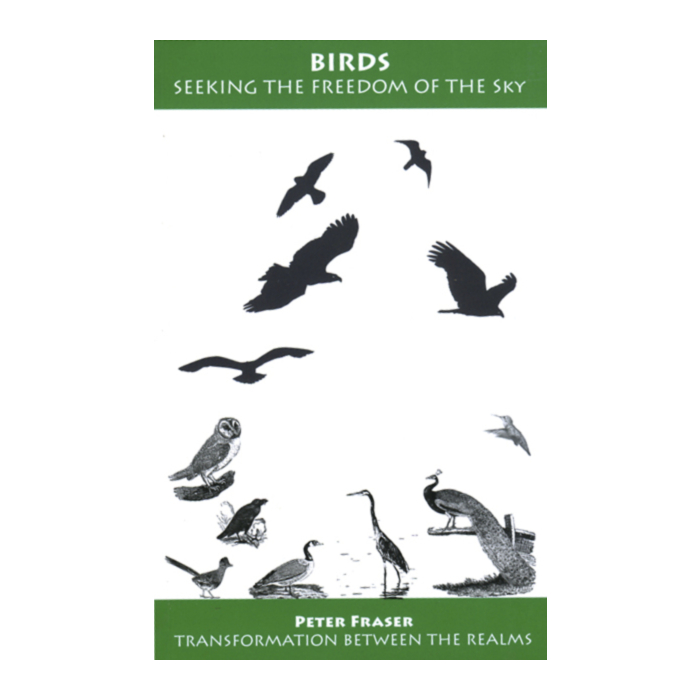Birds - Seeking freedom of the Sky
Share on social media
This book brings together information on forty different remedies, much of it not readily available elsewhere.
It gives a general outline of the features important to birds and how these features are expressed in the Bird Remedies. It then looks at the individual remedies and details the way that particular issues are important in one remedy and less so in others. It also looks at the emerging relationships between bird families and such things as the relationship between predator and prey.
| ISBN | 9781874581215 |
|---|---|
| Author | Peter Fraser |
| Type | Paperback |
| Language | English |
| Publication date | 2009 |
| Pages | 211 |
| Publisher | Winter Press |
| Review | This book review is reprinted from Volume 23, Summer 2010 edition, with permission from Homeopathic Links. Reviewed by Petra Wood, United Kingdom This is another book in the series "Transformation between the Realms" by Peter Fraser. Injust over 200 pages, Peter shares with us his understanding of the Bird remedies. The information appears to mostly be taken directly from provings (some carried out with Peter Fraser's direct involvement, such as Peregrine Falcon and Sparrow) or articles about provings. There is an excellent bibliography at the end of the book, referencing not just proving books, but also articles and websites as well as general reference books for the different Birds discussed. After some interesting considerations about the Birds as a family in general follows information on 38 different Birds, plus Guano and Tuberculinum aviare. The different species are grouped according to their taxonomy with a short introduction to the main characteristics of each subgroup. The description of the different Bird remedies clearly shows the depth to which Peter Fraser has studied the provings: each Bird remedy is differentiated with others that might appear similar, and with what is common to the theme of Birds in general. There is also differentiation with the Insect remedies, which appear similar to some of the Bird remedies, as well as the Drug remedies where similar. Peter summarises similarities and differences in short but clear words. On some occasions I would have appreciated more explanations - the book certainly whets the appetite to find out more about these remedies! It needs to be appreciated that this book is a summary rather than an in-depth work, meaning that it is very affordable, whilst offering the biggest number of different Bird remedies in a single publication. This book will aid the user in narrowing a potential choice of Bird remedies, and with the bibliography further research can then be undertaken in a more focussed way. I would wish that in a further edition the author will take the time to bring some consistency throughout as to the usage of common or Latin names of the different remedies. Here they are used both in a sometimes confusing way - a small criticism of a great little book! |
Review
This book review is reprinted from Volume 23, Summer 2010 edition, with permission from Homeopathic Links.
Reviewed by Petra Wood, United Kingdom
This is another book in the series "Transformation between the Realms" by Peter Fraser. Injust over 200 pages, Peter shares with us his understanding of the Bird remedies. The information appears to mostly be taken directly from provings (some carried out with Peter Fraser's direct involvement, such as Peregrine Falcon and Sparrow) or articles about provings. There is an excellent bibliography at the end of the book, referencing not just proving books, but also articles and websites as well as general reference books for the different Birds discussed.
After some interesting considerations about the Birds as a family in general follows information on 38 different Birds, plus Guano and Tuberculinum aviare. The different species are grouped according to their taxonomy with a short introduction to the main characteristics of each subgroup.
The description of the different Bird remedies clearly shows the depth to which Peter Fraser has studied the provings: each Bird remedy is differentiated with others that might appear similar, and with what is common to the theme of Birds in general.
There is also differentiation with the Insect remedies, which appear similar to some of the Bird remedies, as well as the Drug remedies where similar. Peter summarises similarities and differences in short but clear words.
On some occasions I would have appreciated more explanations - the book certainly whets the appetite to find out more about these remedies! It needs to be appreciated that this book is a summary rather than an in-depth work, meaning that it is very affordable, whilst offering the biggest number of different Bird remedies in a single publication. This book will aid the user in narrowing a potential choice of Bird remedies, and with the bibliography further research can then be undertaken in a more focussed way.
I would wish that in a further edition the author will take the time to bring some consistency throughout as to the usage of common or Latin names of the different remedies. Here they are used both in a sometimes confusing way - a small criticism of a great little book!


